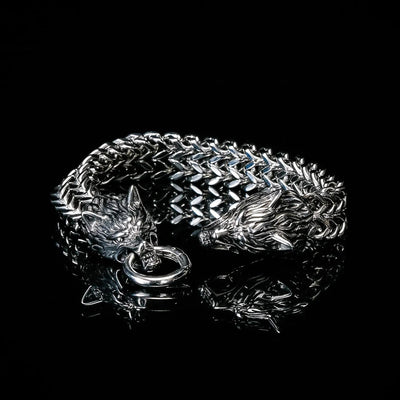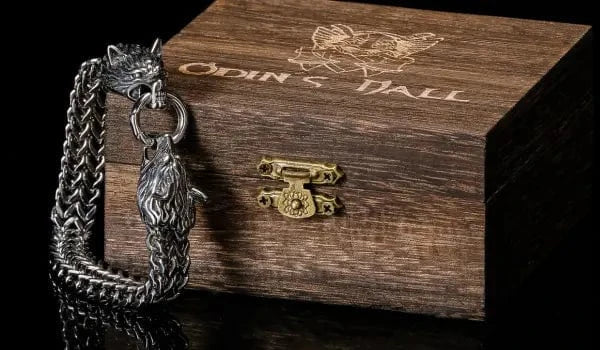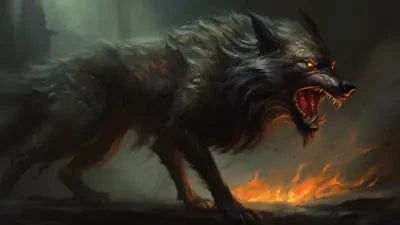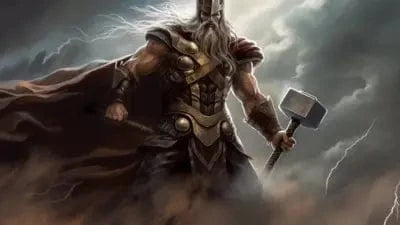Nordic mythology is a fascinating world, filled with gods, incredible stories, legends but most of all creatures. And for sure, without these creatures the Nordic mythology would not have been as exciting as it is today.
These creatures take different forms, quite often that of an animal. Each of them has its own history and own legends. Some fought on the side of the gods while some were fought by the gods.
Take a seat and let us immerse you in this legendary universe.
WOLVES
Fenrir
Fenrir is the wolf, if not the most famous creature in Norse mythology. He is the wolf that Loki gave birth to. He has a brother and sister : Jörmungand and Hel. Fenrir was soon deemed too dangerous in the eyes of the gods, so they wanted to bind him.

46,90€
64,90€
They tried with a first binding, made by the dwarves of Svartalfheim, but the giant wolf broke free. The gods went to the dwarves to ask for a stronger tie. But the second one broke even more quickly than the first. The gods were fed up and decided to go back to the dwarves to ask them for a bond that would not make any noise and that Fenrir would not even be able to feel. Using ingredients that no longer exist today, the dwarves made Gleipnir. Since the ribbon looked no stronger than a blade of grass, Fenrir agreed to let himself be imprisoned on condition that one of the gods agreed to put his arm into the wolf's mouth. Tyr agreed.

The bond, this time worked, preventing Fenrir from breaking free. The gods burst out laughing, seeing that such a menacing monster could not free himself from such a small piece of ribbon. All the gods laughed, except Tyr who had just lost his arm in Fenrir's mouth, which he immediately bit off. He has been known ever since as the one-armed god.
Later, for Ragnarök, he will free himself to go and fulfill his prophecy. So he killed Odin, who was immediately avenged by one of his sons, Vidar.
Garm
Garm is the wolfhound who guards the entrance to the world of the dead. He is often mistaken for Fenrir. He will spend his life chained to the cave of Gnipahellir until Ragnarök where he will go to battle with the one-armed god Tyr and perish against him. The god will eventually succumb to the final blow inflicted on him by Garm.
Geri and Freki
Geri and Freki are the two wolves of Odin. Their names mean " greedy " and " violent " respectively. It is said that the god of gods gives them his food when he goes to Valhalla, thus making do with wine. Odin's two animals are often mentioned in the poems as synonyms for wolves.
Hati and Sköll
Hati and Sköll are the two wolf grandsons of Loki. Their lives were spent chasing Màni and Sól (the moon and the sun) respectively. When the two wolves reach their goal, it will be the beginning of Ragnarök.
DRAAGONS AND SERPENTS
Nidhogg
Nidhogg (modern anglicised spelling), or Níðhöggr, is a dragon that gnaws at the roots of Yggdrasil. In Norse culture, the word Nest represented loss of status in society and was reserved for the outcasts of society. Therefore we can connect Nidhogg with the lowest part of society. According to the Nordic myth envisaged in Poetic Edda, and its Voluspa part, the gnawing performed by Nidhogg, ate souls that ended up in Nastrond, the part of Hel that contained the souls of the worst humans in the Viking world. Nidhogg is also mentioned at the end of Voluspa, where we have a description of Ragnarok and Nidhogg as one of the harbingers where he comes with his wings spread and dead people on them.

According to the Prose Edda part, Gylfaginning, many creatures live on Yggdrasil. Besides Nidhogg, who is mentioned as a snake in this context, there is also Ratatoskr, a squirrel that sends envious messages between Nidhogg at the foot of the tree and a huge eagle (whose name is not mentioned here). In the other part, Skaldskaparmal, Nidhogg is mentioned as one of the dragons that inhabit the world.
The role of Nidhogg is not entirely clear as he may be used as the bearer of news indicating the end of the world , but his final act could also mean that he has achieved redemption. Of course, as the dragon who ate the souls of evildoers at the roots of the world tree Yggdrasil, he was also a pretty powerful cautionary tale. I really don't know who wouldn't be frightened by the words " the giant snake that lives at the roots of Yggdrasil is going to eat you unless you change your behavior ".
Jörmungand
Jormungand, also known as the Midgard serpent, is the creature that encircles Midgard, biting its tail at the end of the world. His father is the trickster God Loki, and his mother is the giantess Angrbroda. Jormungand was cast into the great sea of Midgard by the god Odin, where he grew so much that he was able to encircle the Earth.
Although the story of Jormungand begins with Odin, the god who has the most connection to Jormungand throughout Norse myth is Odin's son, the god of thunder, Thor. Norse mythology mentions three occasions when these two met.
The first time was when Odin was racing for the giant king Utgarda-Loki. There, as a show of strength, the king asked Thor to lift a colossal cat, which was actually Jormungand in disguise. Of course, Thor couldn't do it, but to everyone's surprise, he managed to lift one of its legs off the ground, which was considered an impressive feat.
The second time they met was when Thor went fishing with the giant Hymir. On this trip, Hymir did not want to provide Thor with the bait for the fishing, so he took the head of Hymir's largest ox. While they were fishing, Thor was not satisfied with his catch, so he persuaded Hymir that they were going deeper and deeper into the sea when at one point Thor pulled Jormungand out of the water. Just as he was about to kill him, Hymir cut the line and released the dragon into the sea.
The third and final encounter between Thor and Jormungand is supposed to take place in Ragnarok, which would begin when Jormungand releases his tail and arrives from the sea. At this point, the thunder god will kill the serpent Jormungand but will die after nine stages as he will be poisoned by the dragon. This would also mean the end of Ragnarök.
Fafnir
The story of Fafnir begins with Loki, Odin and Hoenir, who, during their travels, killed an otter that turned out to be a dwarf Otr, son of the dwarf king Hreidmar. When Hreidmar learned that they had killed his son, he and his two sons, Fafnir and Regis, captured the three gods, refusing to release them until they paid a golden ransom. Knowing this, Loki agreed but gave them Andvari gold, which would be cursed, and the Andvaranaut ring, which would bring death to anyone wearing it. Jealous of all this gold, Fafnir killed his father, the king, and took all the gold treasure. After a while, he turned into a creature that was said to be something like a dragon, which breathed fire and spread poison throughout the land. He did everything in his power to accumulate all this wealth.
Long after this, Regis, Fafnir's brother, wanted the golden treasure for himself. Since he could not kill his brother, he sent his son-in-law Sigurd to seek and kill Fafnir. After a long and fierce battle, the young warrior managed to kill Fafnir. As he was dying, Fafnir wanted to know who was the powerful warrior who had managed to kill him. When he heard that his own brother Regis had sent him, he predicted that Regis would also kill Sigurd. After Sigurd killed Fafnir, he decided to get the treasure for himself. Regis obviously couldn't stand for something like this to happen, so he decided to kill Sigurd and collect the treasure himself. What he didn't know was that while he was cooking the dragon's heart, he tasted it. From that moment on, he could understand the language of animals, so he heard from two birds that his father wants to kill him. Of course, this did not happen, and Sigurd killed his father with the same sword that he had used to kill the dragon and took the treasure. He said that he did not fear receiving the death curse since all men die.
OTHER CREATURES
Audhumla
Audhumla is the nurturing cow of Norse mythology. She was born from the fusion of the dawn of time and ice. Ymir fed on the four rivers of milk that flowed from Audhumla.
Gullfaxi
Gullfaxi is the horse with the golden mane the fastest horse in Norse mythology according to legends. It belonged to the giant Hrungnir. Later, the giant was killed by Thor, so Gullfaxi was given to his son Magni. In addition to running fast, it has the strange power to fly, swim but also to travel from world to world.
Hugin and Munin
They are the famous Corbels of Odin, meaning thought and memory respectively.
The Kraken
The Kraken is a legendary sea creature. It was the biggest scare for Vikings sailing to new lands (after Thor's wrath, of course). And for good reason, the Kraken has the ability to single-handedly grab the hull of a ship to sink it and devour all its travellers.
Sleipnir
Sleipnir is the eight-legged horse of Odin. He has several peculiarities besides belonging to the god of gods. Indeed, he moves very fast. The legends say that he moves as fast as Gullfaxi, the golden horse. Moreover, he can gallop on water and in the air, which is very practical. Sleipnir is the son of Loki and a stallion: Svaðilfari. In order to give birth to this child, Loki had to transform himself into a mare, thus becoming the first transgender god.
Get in your drakkar and continue browsing our site:





